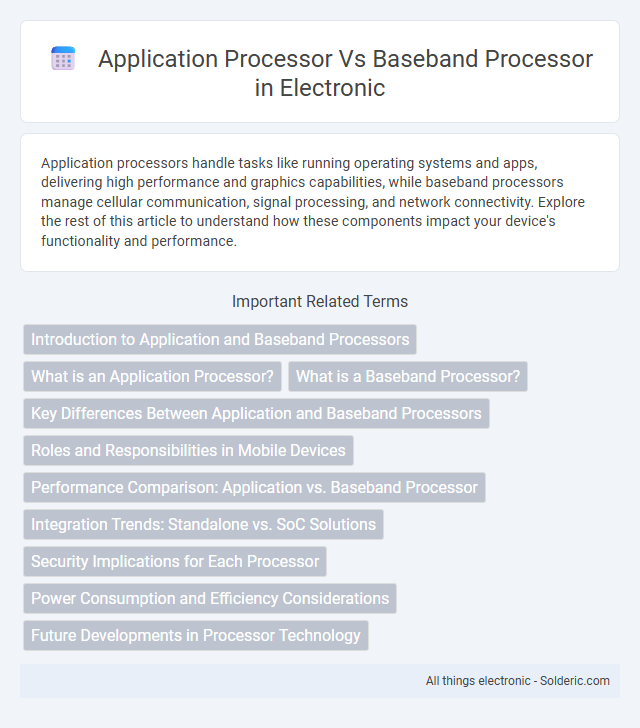Application processors handle tasks like running operating systems and apps, delivering high performance and graphics capabilities, while baseband processors manage cellular communication, signal processing, and network connectivity. Explore the rest of this article to understand how these components impact your device's functionality and performance.
Comparison Table
| Feature | Application Processor | Baseband Processor |
|---|---|---|
| Primary Function | Runs operating system and applications | Manages cellular communication and signal processing |
| Core Architecture | High-performance CPUs (ARM Cortex, Apple A-series) | Specialized DSP and ARM cores optimized for radio tasks |
| Operating System | Android, iOS, Linux, Windows | Real-time operating systems (RTOS) |
| Functionality | Multimedia, user interface, application execution | Voice call, SMS, LTE/5G protocol stack management |
| Communication | Interfaces with baseband via high-speed buses (e.g., PCIe) | Handles modem tasks, baseband signal modulation/demodulation |
| Examples | Qualcomm Snapdragon, Apple A14 Bionic | Qualcomm Snapdragon modem, MediaTek Helio modem |
| Power Consumption | Higher due to complex processing and UI rendering | Optimized for power efficiency during constant signal processing |
Introduction to Application and Baseband Processors
Application processors handle complex computing tasks and run the operating system, applications, and multimedia functions on smartphones, tablets, and other smart devices. Baseband processors manage radio communications, including cellular signal processing, network connectivity, and voice transmission, ensuring effective communication with mobile networks. Your device's performance and connectivity rely on the seamless integration of both application and baseband processors.
What is an Application Processor?
An Application Processor (AP) is a central component in smartphones and tablets responsible for running the operating system, executing applications, and managing user interface tasks. It integrates CPU cores, GPU, memory controllers, and other subsystems to provide high-performance computing and multimedia capabilities. Unlike the baseband processor, which handles cellular communication and signal processing, the Application Processor focuses on delivering a seamless user experience and running software applications.
What is a Baseband Processor?
A baseband processor is a specialized chip in mobile devices responsible for managing all radio functions, including communication with cellular networks such as LTE, 5G, or GSM. It handles signal processing, modulation, and demodulation to ensure seamless wireless connectivity and voice call management. Your device depends on the baseband processor for reliable network performance and secure transmission of data over cellular signals.
Key Differences Between Application and Baseband Processors
Application processors handle complex tasks such as running operating systems, apps, and user interfaces, providing the processing power needed for multitasking and multimedia functions. Baseband processors manage communication protocols and signal processing for cellular networks, ensuring reliable voice and data transmission over mobile networks. Your device relies on this division of labor to deliver seamless connectivity alongside powerful user experiences.
Roles and Responsibilities in Mobile Devices
Application processors manage high-level functions such as running operating systems, executing apps, handling multimedia tasks, and supporting user interfaces in mobile devices. Baseband processors focus on communication tasks, including cellular modem operations, signal processing, and managing radio frequency protocols to enable voice and data transmission over mobile networks. Together, they ensure seamless device performance by splitting computational and communication workloads effectively.
Performance Comparison: Application vs. Baseband Processor
Application processors deliver high-performance computing optimized for running complex operating systems, user interfaces, and multimedia applications, featuring multi-core CPUs and advanced GPUs. Baseband processors specialize in real-time signal processing for cellular communication, emphasizing power efficiency and low latency to handle tasks such as modulation, demodulation, and protocol stack execution. Performance differences arise as application processors prioritize computational speed and graphics performance, while baseband processors focus on reliable, efficient wireless communication management.
Integration Trends: Standalone vs. SoC Solutions
Application processors and baseband processors are increasingly integrated into single System on Chip (SoC) solutions, enhancing power efficiency and communication speed in smartphones and IoT devices. Standalone baseband processors persist primarily in specialized applications requiring modular upgrades or legacy support. The trend toward SoC solutions enables streamlined hardware design, reduced manufacturing costs, and improved performance through tighter coupling of processing cores and communication modules.
Security Implications for Each Processor
Application processors handle complex operating systems and run user applications, making them vulnerable to malware and software attacks that can compromise sensitive data. Baseband processors manage cellular communication protocols and are critical for network security, but their closed-source firmware and limited security updates increase the risk of undetected exploits targeting phone calls and data transmission. Ensuring your device's security requires understanding these distinct vulnerabilities and applying regular software and firmware updates to both processors.
Power Consumption and Efficiency Considerations
Application processors generally consume more power due to their complex functions like running operating systems and multiple applications simultaneously, requiring advanced power management techniques to maintain efficiency. Baseband processors are optimized for communication tasks such as signal processing and network connectivity, resulting in lower power consumption and higher efficiency in handling cellular protocols. Your device benefits from this division by balancing intensive application performance with energy-efficient network communication, extending battery life without sacrificing functionality.
Future Developments in Processor Technology
Future developments in application and baseband processors emphasize enhanced integration of AI capabilities and 5G support, improving overall device performance and connectivity. Application processors are evolving with advanced multi-core architectures and energy-efficient designs to handle complex computing tasks and AI-driven applications. Baseband processors focus on supporting emerging communication standards such as 5G NR and future 6G protocols, optimizing signal processing and network efficiency for faster data speeds and lower latency.
Application processor vs baseband processor Infographic

 solderic.com
solderic.com